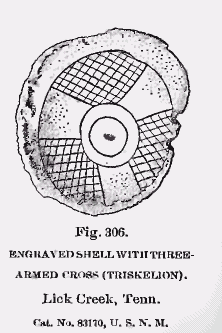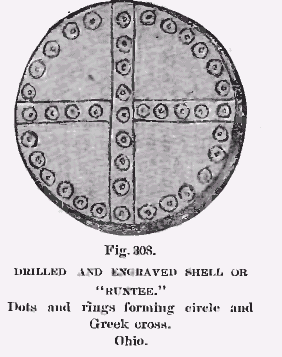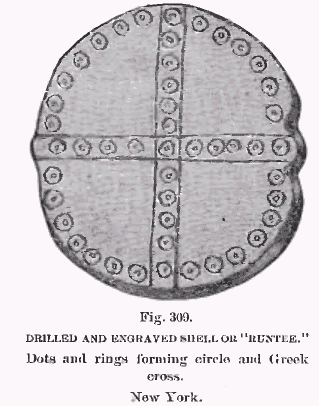

The Swastika
The Cross Among The American Indians
There is also introduced, as bearing on the question, another shell ornament
 (fig.
306), the style, design, and workmanship of which has such resemblance
to the foregoing that if they had not been (as they were) found together
we would be compelled to admit their identity or origin, yet the latter
specimen has but three arms instead of four. This might take it out of
the category of crosses as a symbol of any religion of which we have knowledge.
Many of the art objects in shell heretofore cited were more or less closely
associated; they came from the same neighborhood and were the results
of the same excavations, conducted by the same excavators. In determining
the culture status of their makers, they must be taken together.
(fig.
306), the style, design, and workmanship of which has such resemblance
to the foregoing that if they had not been (as they were) found together
we would be compelled to admit their identity or origin, yet the latter
specimen has but three arms instead of four. This might take it out of
the category of crosses as a symbol of any religion of which we have knowledge.
Many of the art objects in shell heretofore cited were more or less closely
associated; they came from the same neighborhood and were the results
of the same excavations, conducted by the same excavators. In determining
the culture status of their makers, they must be taken together.When we consider the variety of the designs which were apparently without meaning except for ornamentation, like the circles, meanders, zigzags, chevrons, herringbones, ogees, frets, etc., and the representations of animals such as were used to decorate the pipes of the aborigines, not alone the bear, wolf, eagle, and others which might be a totem and represent a given clan, but other which, according to our knowledge and
 imagination,
have never served for such a purpose, as the manatee, beaver, wildcat,
heron, finch, sparrow, crow, raven, cormorant, duck, toucan, goose, turkey,
buzzard, cardinal, parroquet, conies, lizard; when we further consider
that the cross, whether Greek, Latin, or Swastika form, is utterly unlike
any known or possible totem of clan, insignia of ruler, or potent charm
of priesthood; when we consider these things, why should we feel ourselves
compelled to accept these signs as symbols of a hidden meaning, simply
because religious sects in different parts of the world and at different
epochs of history have chosen them or some of them to represent their
peculiar religious ideas? This question covers much space in geography
and in time, as well as on paper. It is not answered here, because no
answer can be given which would be accepted as satisfactory, but it may
serve as a track or indication along which students and thinkers might
pursue their investigations.
imagination,
have never served for such a purpose, as the manatee, beaver, wildcat,
heron, finch, sparrow, crow, raven, cormorant, duck, toucan, goose, turkey,
buzzard, cardinal, parroquet, conies, lizard; when we further consider
that the cross, whether Greek, Latin, or Swastika form, is utterly unlike
any known or possible totem of clan, insignia of ruler, or potent charm
of priesthood; when we consider these things, why should we feel ourselves
compelled to accept these signs as symbols of a hidden meaning, simply
because religious sects in different parts of the world and at different
epochs of history have chosen them or some of them to represent their
peculiar religious ideas? This question covers much space in geography
and in time, as well as on paper. It is not answered here, because no
answer can be given which would be accepted as satisfactory, but it may
serve as a track or indication along which students and thinkers might
pursue their investigations. The U. S. National Museum possesses a necklace consisting of three shell
 ornaments,
interspersed at regular intervals with about fifty small porcelain beads
(figs. 307). (1) It was obtained
by Capt. George M. Whipple from the Indians of New Mexico. These shell
ornaments are similar to objects described by Beverly in his work on the
"History of Virginia," page 145, as "runtees" and
"made of the conch shell; only the shape is flat as a cheese and
drilled edgewise." It is to be remarked that on its face as well
as on figs. 308 and 309 (1) appears a cross of
the Greek form indicated by these peculiar indentations or drillings enclosed
in a small circle. The specimen shown in fig. 308 is from an ancient grave
in Upper Sandusky, Ohio, and that shown in fig. 309 form an Indian cemetery
at Onondaga, N. Y. Similar specimens have been found in the same localities.
ornaments,
interspersed at regular intervals with about fifty small porcelain beads
(figs. 307). (1) It was obtained
by Capt. George M. Whipple from the Indians of New Mexico. These shell
ornaments are similar to objects described by Beverly in his work on the
"History of Virginia," page 145, as "runtees" and
"made of the conch shell; only the shape is flat as a cheese and
drilled edgewise." It is to be remarked that on its face as well
as on figs. 308 and 309 (1) appears a cross of
the Greek form indicated by these peculiar indentations or drillings enclosed
in a small circle. The specimen shown in fig. 308 is from an ancient grave
in Upper Sandusky, Ohio, and that shown in fig. 309 form an Indian cemetery
at Onondaga, N. Y. Similar specimens have been found in the same localities. Fig.
310 shows a small globular cup of dark ware from the vicinity of Charleston,
Mo.; height, 2 ½ inches; width, 3½ inches. It has four large
nodes or projections, and between them, painted red, are four ornamental
circles, the outside one of which is scalloped or rayed, while the inside
one bears the figure of a Greek cross. The specimen shown in fig.
311 (Cat. No. 47197, U. S. N. M.) is a medium-sized decorated olla
with scalloped margin, from new Mexico, collected by Colonel Stevenson.
It has two crosses --- one Greek, the other Maltese --- both enclosed
in circles and forming centers of an elaborate, fanciful, shield-like
decoration. In fig. 312 (Cat.
No. 39518, U. S. N. M.) is shown a Cochiti painted water vessel, same
collection, showing a Maltese cross.
Fig.
310 shows a small globular cup of dark ware from the vicinity of Charleston,
Mo.; height, 2 ½ inches; width, 3½ inches. It has four large
nodes or projections, and between them, painted red, are four ornamental
circles, the outside one of which is scalloped or rayed, while the inside
one bears the figure of a Greek cross. The specimen shown in fig.
311 (Cat. No. 47197, U. S. N. M.) is a medium-sized decorated olla
with scalloped margin, from new Mexico, collected by Colonel Stevenson.
It has two crosses --- one Greek, the other Maltese --- both enclosed
in circles and forming centers of an elaborate, fanciful, shield-like
decoration. In fig. 312 (Cat.
No. 39518, U. S. N. M.) is shown a Cochiti painted water vessel, same
collection, showing a Maltese cross.Dozens of other specimens are in the collections of the U. S. National Museum which would serve to illustrate the extended and extensive
ENDNOTES:
1. Schoolcraft, "History of the Indian Tribes," III, pl. 25; Second Ann. Rep. Bureau of Ethnology, 1880-81, pl. 36 [Back]
<< Previous Page Next Page >>
© 2004-2007 Northvegr.
Most of the material on this site is in the public domain. However, many people have worked very hard to bring these texts to you so if you do use the work, we would appreciate it if you could give credit to both the Northvegr site and to the individuals who worked to bring you these texts. A small number of texts are copyrighted and cannot be used without the author's permission. Any text that is copyrighted will have a clear notation of such on the main index page for that text. Inquiries can be sent to info@northvegr.org. Northvegr™ and the Northvegr symbol are trademarks and service marks of the Northvegr Foundation.

|